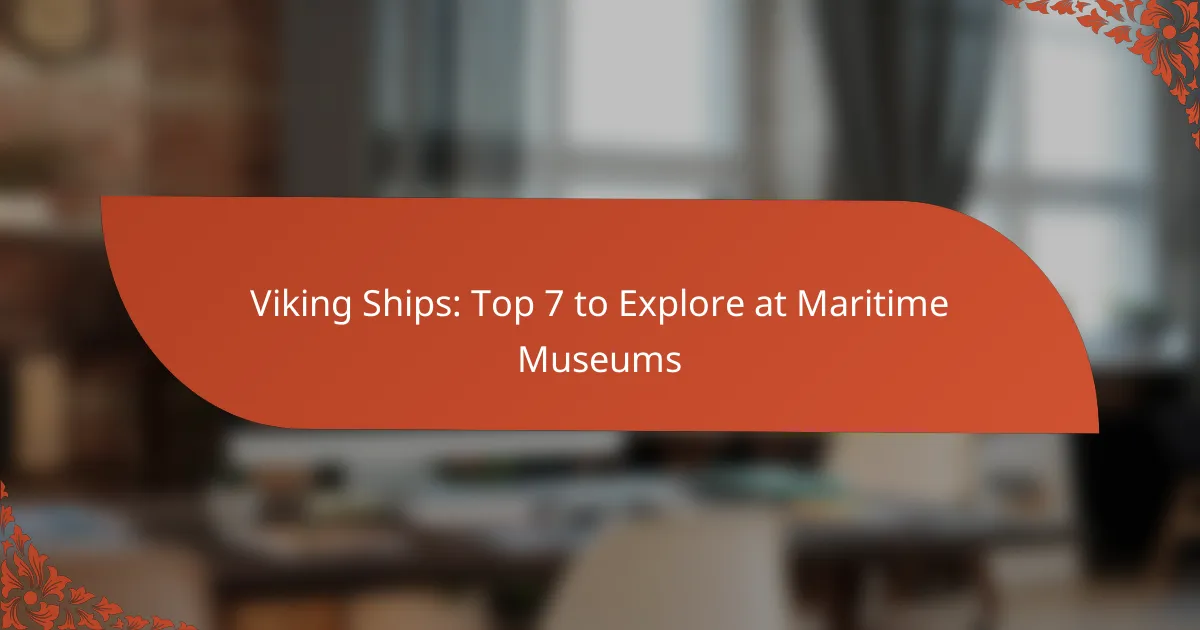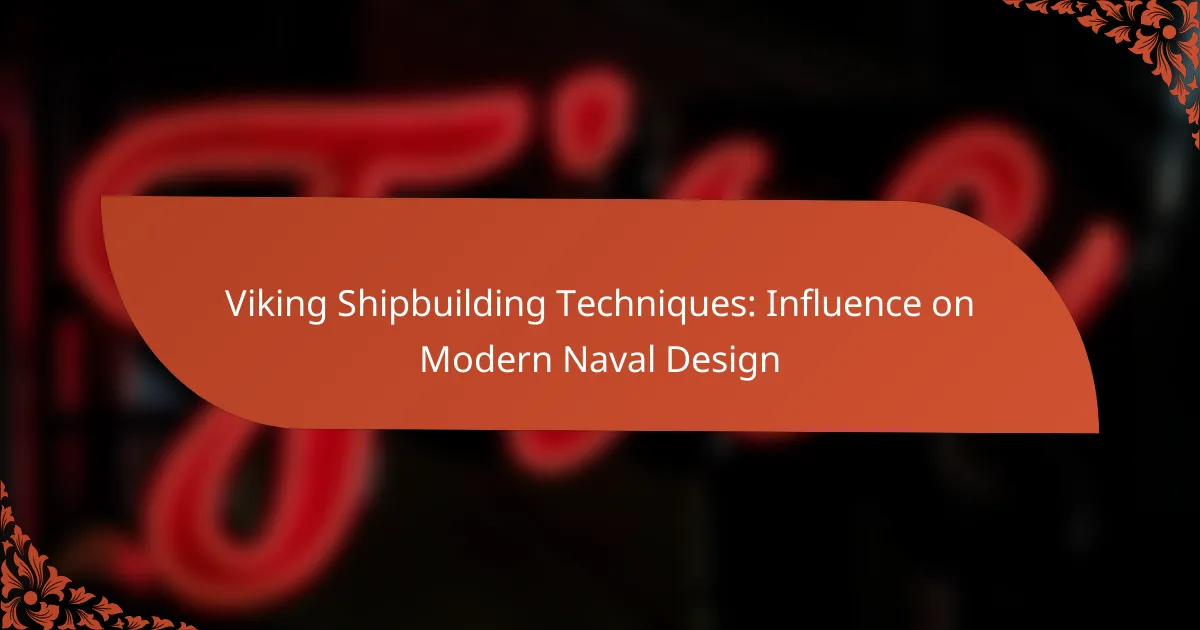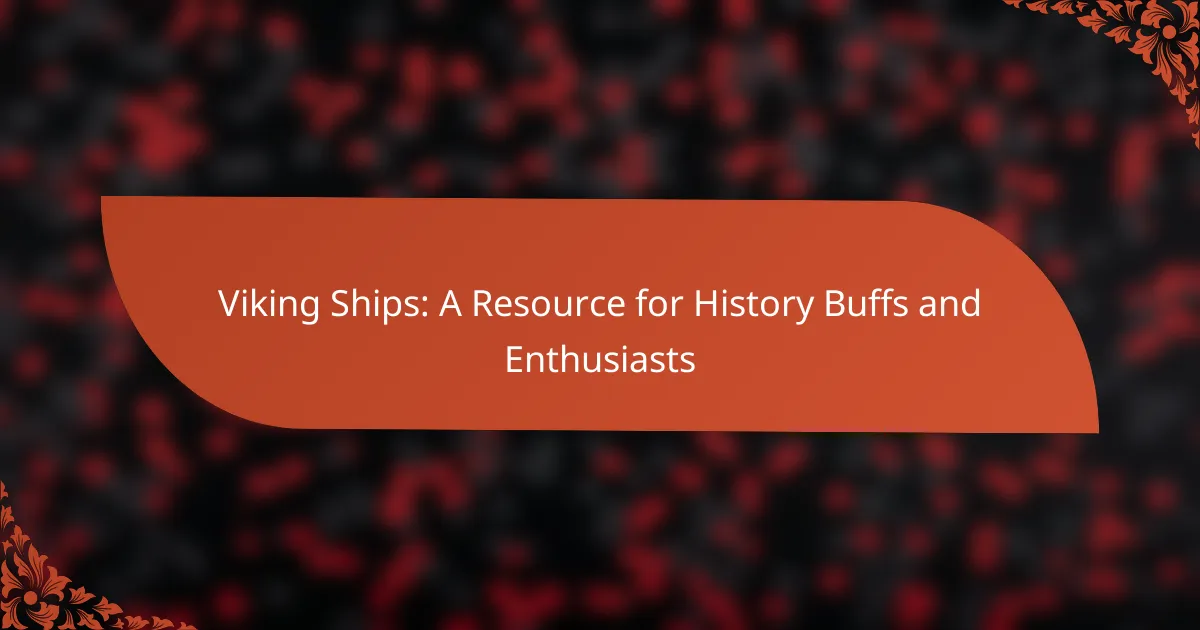Viking ships played a crucial role in Norse society, serving as vessels for trade, exploration, and warfare. Their innovative design not only facilitated efficient maritime transport but also transformed cultural exchanges across Scandinavia and beyond. With features that optimized speed and navigability, these ships were instrumental in the Vikings’ ability to launch swift military operations and establish extensive trade networks.

How did Viking ships influence trade in Scandinavia?
Viking ships significantly influenced trade in Scandinavia by enabling efficient maritime transport, which facilitated the exchange of goods and culture across vast distances. Their advanced design allowed for both coastal and river navigation, making trade routes more accessible and diverse.
Enhanced maritime commerce
The design of Viking ships, particularly their longships, allowed for swift and agile movement across the seas, enhancing maritime commerce. These vessels could navigate shallow waters, enabling traders to access inland markets that were previously unreachable.
As a result, Viking traders could transport a variety of goods, including furs, amber, and metalwork, which were highly sought after in Europe and beyond. This not only boosted local economies but also established Scandinavia as a key player in international trade networks.
Facilitated cultural exchange
Viking ships were instrumental in facilitating cultural exchange between different societies. As Vikings traveled to various regions, they brought with them not only goods but also ideas, technologies, and cultural practices.
This exchange enriched Norse society, leading to the adoption of new agricultural techniques, artistic styles, and even religious beliefs. The interactions fostered by these voyages contributed to a more interconnected world during the Viking Age.
Expanded trade routes
The capabilities of Viking ships allowed for the expansion of trade routes across Europe, Asia, and even North America. They established connections with the Byzantine Empire, the Islamic world, and various tribes in the British Isles, creating a vast network of commerce.
These routes were not only crucial for economic growth but also for the spread of innovations such as shipbuilding techniques and navigational skills. The establishment of these trade routes laid the groundwork for future economic relationships and cultural ties across continents.

What were the key features of Viking ships?
Viking ships were renowned for their advanced design, which included features that optimized them for speed, cargo capacity, and navigation. Key characteristics included a shallow draft, a flexible hull, and a symmetrical shape, enabling them to traverse both open seas and shallow rivers efficiently.
Longships for speed
Longships were the fastest vessels in the Viking fleet, designed for raiding and quick travel. Their sleek, elongated shape and shallow draft allowed them to glide swiftly over water, making them ideal for surprise attacks along coastlines and rivers.
Typically, longships were powered by both sails and oars, providing versatility in various weather conditions. This dual propulsion system enabled them to maintain speed even in light winds, a crucial advantage during naval engagements.
Knarrs for cargo
Knarrs were the cargo ships of the Vikings, built for transporting goods over long distances. Unlike longships, knarrs had a broader hull and deeper draft, which provided greater stability and capacity for carrying trade items such as timber, furs, and even livestock.
These vessels were essential for establishing trade routes across Europe and beyond, allowing the Vikings to exchange goods with other cultures. Their design facilitated the transport of heavier loads, making them vital for economic expansion during the Viking Age.
Dragon-headed prows
The iconic dragon-headed prows of Viking ships served both practical and symbolic purposes. These ornate figureheads were designed to intimidate enemies and showcase the craftsmanship of the builders, often reflecting Norse mythology and culture.
Additionally, the prows helped to cut through waves, improving the ship’s performance in rough seas. The use of such decorative elements also indicated the status of the ship’s owner, as more elaborate designs were associated with wealth and power within Norse society.

How did Viking ships impact warfare?
Viking ships significantly transformed warfare by enabling swift and strategic military operations. Their design allowed for rapid movement across various terrains, making them essential for both offensive and defensive tactics.
Rapid troop deployment
Viking ships facilitated the quick transport of warriors to battle sites, often covering distances of several hundred kilometers in a matter of days. This speed allowed Viking forces to mobilize rapidly, catching opponents off guard and gaining the upper hand in conflicts.
The shallow draft of these ships enabled them to navigate rivers and shallow waters, allowing for troop deployment in locations that larger vessels could not access. This adaptability was crucial for launching surprise raids on coastal settlements and inland targets.
Surprise attacks
Viking ships were instrumental in executing surprise attacks, a hallmark of their military strategy. Their ability to approach shorelines stealthily, often under the cover of darkness, allowed them to strike before the enemy could mount a defense.
These surprise raids often targeted unprepared villages, leading to significant psychological impacts on their adversaries. The fear of sudden Viking incursions contributed to the reputation of Vikings as formidable warriors throughout Europe.
Naval dominance
The construction and design of Viking ships established naval dominance in the North Atlantic and beyond. Their longships, equipped with sails and oars, combined speed with maneuverability, allowing Vikings to control trade routes and engage in naval battles effectively.
By dominating the seas, Vikings could protect their interests, raid coastal towns, and establish settlements across various regions. This naval superiority played a crucial role in expanding their influence and power during the Viking Age.

What role did Viking ships play in exploration?
Viking ships were crucial for exploration, enabling Norse seafarers to navigate vast distances across oceans and rivers. Their advanced design allowed for both speed and agility, facilitating the discovery of new territories and trade routes.
Discovery of new lands
The design of Viking ships, particularly the longship, was instrumental in the discovery of new lands. These vessels could traverse both open seas and shallow rivers, allowing Vikings to explore diverse environments. This adaptability led to the identification of territories such as Iceland and Greenland, expanding their reach significantly.
Settlement in Greenland
Viking exploration led to the settlement of Greenland in the late 10th century. Norse settlers, primarily from Norway, established farms and communities, taking advantage of the land’s resources. The settlements thrived for several centuries, showcasing the Vikings’ ability to adapt to new environments.
Voyages to North America
Viking ships also facilitated voyages to North America, with the most notable landing at L’Anse aux Meadows around the year 1000. This site, located in present-day Newfoundland, Canada, serves as evidence of Norse exploration beyond Greenland. The expeditions to North America highlight the Vikings’ maritime skills and their role in early transatlantic exploration.

How were Viking ships constructed?
Viking ships were constructed using a combination of traditional woodworking techniques and innovative designs that maximized their seaworthiness and speed. The process involved selecting the right materials, employing specific building methods, and integrating advanced sail technology to create vessels capable of long voyages and exploration.
Wood selection and techniques
The primary wood used in Viking ship construction was oak due to its strength and durability. Builders often selected trees with a straight grain and minimal knots, which provided the best structural integrity. Techniques such as steaming and bending allowed craftsmen to shape the wood into the desired forms without compromising its strength.
Other woods like pine and birch were also utilized for specific components, such as the deck and interior fittings. The choice of wood was crucial, as it affected the ship’s weight, buoyancy, and overall performance in various sea conditions.
Use of clinker building
Clinker building is a technique where wooden planks are overlapped and fastened together, creating a flexible and lightweight hull. This method allowed Viking ships to withstand the harsh conditions of the North Atlantic while maintaining speed and agility. The overlapping design also contributed to the ship’s ability to navigate shallow waters and beach landings.
Viking shipbuilders used iron rivets to secure the planks, ensuring a strong bond that could endure the stresses of ocean travel. This construction method was not only practical but also reflected the craftsmanship and ingenuity of Norse society.
Innovative sail design
The sails of Viking ships were typically made from wool or linen, designed to catch the wind efficiently and propel the vessel forward. The square sail design was revolutionary, allowing for better wind capture and maneuverability compared to earlier sail types. This innovation enabled Vikings to travel faster and more effectively across open waters.
Viking ships often featured a single mast with a sail that could be raised or lowered, providing flexibility in changing wind conditions. The ability to adjust the sail quickly was essential for navigating the unpredictable waters of the North Sea and Baltic Sea, enhancing the Vikings’ reputation as formidable seafarers.

What cultural significance did Viking ships hold?
Viking ships were vital to Norse society, serving as symbols of exploration, trade, and warfare. Their design and usage reflected the social hierarchy, religious beliefs, and artistic expression of the Viking Age.
Symbol of status and power
Viking ships represented the status and power of their owners, often reflecting wealth and influence within the community. Larger ships, like the longships, were typically owned by chieftains or wealthy merchants and were used for raids and trade, showcasing their owner’s resources.
The craftsmanship of a ship could also indicate social standing, with intricately carved prows and elaborate decorations signifying prestige. Ownership of a ship was a key factor in establishing one’s reputation and authority in Norse society.
Religious and ceremonial uses
Viking ships held significant religious and ceremonial importance, often used in burial rites for prominent individuals. High-ranking warriors were interred in ships, accompanied by grave goods, to ensure their safe passage to the afterlife.
Additionally, ships were sometimes used in rituals to honor gods and goddesses, reflecting the deep connection between maritime culture and spirituality in Norse beliefs. These practices underscored the ship’s role as a vessel not only for travel but also for spiritual journeys.
Artistic representations
Artistic representations of Viking ships can be found in various forms, including carvings, tapestries, and runestones. These artworks often depicted ships in action, symbolizing adventure and the Viking spirit of exploration.
Moreover, the design elements of ships influenced Norse art, with motifs from shipbuilding appearing in jewelry and household items. This artistic legacy highlights the integral role of ships in shaping cultural identity and expression during the Viking Age.









